WORKING GROUP DRAFT – IN CONFIDENCEReport on Government Services 2026
PART F, SECTION 14: RELEASED ON 29 JANUARY 2026
14 Aged care services
This section focuses on government funded care and support services for older people and their carers, which are provided at home, in the community and in residential care facilities.
The Indicator results tab uses data from the data tables to provide information on the performance for each indicator in the Indicator framework. The same data is also available in CSV format.
Data downloads
![]() 14 Aged care services data tables (XLSX 839.1 KB)
14 Aged care services data tables (XLSX 839.1 KB)
![]() 14 Aged care services dataset (CSV 2.5 MB)
14 Aged care services dataset (CSV 2.5 MB)
Refer to the corresponding table number in the data tables for detailed definitions, caveats, footnotes and data source(s).
Objectives for aged care services
The aged care system aims to promote the wellbeing and independence of older people (and their carers), by enabling them to stay in their own homes or assisting them in residential care. Governments seek to achieve this aim by subsidising aged care services that are:
- accessible - including timely and affordable
- appropriate to meet the needs of clients - person-centred, with an emphasis on integrated care, ageing in place and restorative approaches
- high quality and safely delivered
- sustainable.
Governments aim for aged care services to meet these objectives in an equitable and efficient manner.
As people age, they may need care and support to maintain health, social connectedness, wellbeing and independence to remain in their homes and communities. In 2022, 39.8% of people aged 65 years and older reported needing assistance as they aged (1.7 million people) (ABS 2024). Family members, friends and neighbours provide much of the care and support for older people (ABS 2024). However, not everyone’s care needs can be met through informal care and support. Around 80% of older people will access some form of government funded aged care service before death (AIHW 2018).
Government funded aged care services are provided to older people (all people aged 65 years and over and Aboriginal and Torres Strait Islander people aged 50–64 years) who have been assessed as eligible for subsidised care through an Aged Care Assessment Team (ACAT) application process. Aged care services assist people who can no longer live without support to access appropriate care in their homes, in the community or in residential care facilities. Approved aged care service providers receive government funding to provide services and are required to meet minimum standards of care.
Regulation and policy oversight of aged care services are predominantly the role of the Australian Government. The Aged Care Act 1997 (Cth) and the accompanying Aged Care Principles are the main regulatory instruments establishing the framework for aged care services in Australia.
The Australian Government funds residential aged care, home care and home support, with state, territory and local governments also funding and/or delivering some of these services directly – for example, a small proportion of residential aged care facilities are owned by state and territory governments. However, most services are delivered by non-government providers (tables 14A.11 −12), such as private-for-profit, religious and charitable organisations.
While the Australian Government subsidises a significant portion of the cost of providing aged care, clients and residents are expected to contribute where they can and may be charged fees by service providers.
In 2023-24, government recurrent expenditure on aged care services was $36.4 billion or $7,452 per older person (table 14A.5 and figure 14.1). Residential and flexible care services accounted for the largest proportion of expenditure in 2023-24 ($22.6 billion, or 62.2%). Home care and home support services accounted for much of the remainder ($11.5 billion) (table 14A.4).
The Australian Government provided 98.9% of government funding for aged care services in 2023-24. State and territory governments provided the remainder (table 14A.4). Detailed expenditure data by program is contained in tables 14A.4-9.
In 2023-24, operating expenses for the Aged Care Quality and Safety Commission (ACQSC) were $268.6 million (table 14A.4).
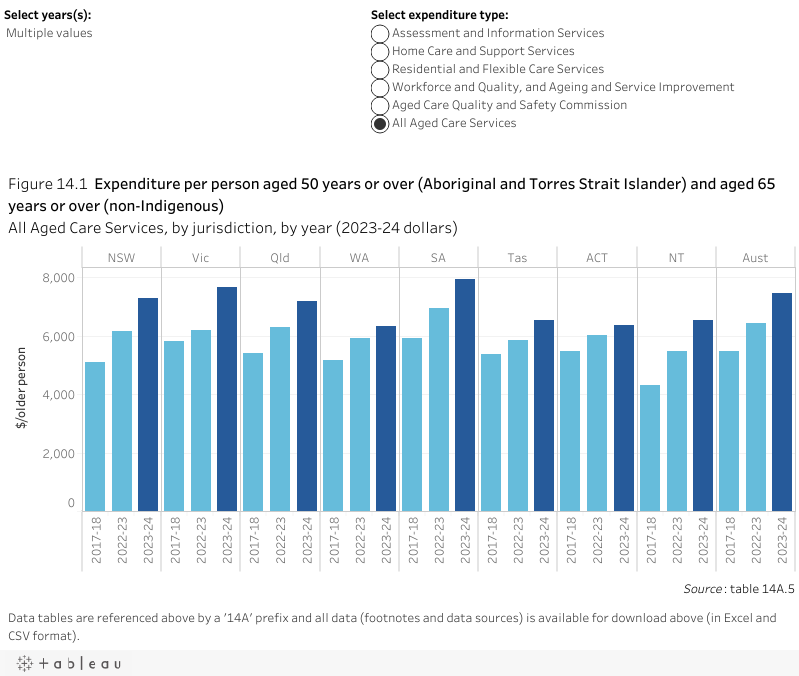
Aged care target population
The size and health of the older population drive demand for aged care services. The Australian population is ageing rapidly, with the share of the population aged 65 or over expected to increase by 6.1 percentage points to reach 23.4% between 2022-23 and 2062-63 (Australian Government 2023). Although the Aboriginal and Torres Strait Islander population is also ageing, life expectancy at birth for Aboriginal and Torres Strait Islander people is lower than that of the non-Indigenous population (ABS 2023).
The aged care target population is defined as all people aged 65 years and over and Aboriginal and Torres Strait Islander people aged 50–64 years (this aligns with funding arrangements specified under the National Health Reform Agreement). The aged care target population differs from the Australian Government’s aged care ‘planning population’, which is used to allocate places under the Aged Care Act. Refer to the 'Explanatory material' tab for a definition of the aged care planning population and table 14A.1 for the populations.
Types of care and support
Home care and support
Governments provide services to help older people remain in their homes or return to their homes from hospital or respite care. Carers can also access respite care through home care and home support programs:
- the Commonwealth Home Support Programme (CHSP) provides entry-level support services to help older people live independently and safely at home and in their community. Table 14A.20 provides a full list of CHSP services. Nationally, in 2023-24, there were 829,043 older CHSP clients, equivalent to around 169.9 older clients per 1,000 older people (table 14A.2).
- the Home Care Packages Program provides more complex in home care tailored to assessed levels of need (level 1 Home Care Packages assist older people with low-care needs, while level 4 packages support high-care needs). Nationally, in 2023-24, there were 333,852 older clients of Home Care Packages, equivalent to around 68.4 older clients per 1,000 older people (table 14A.2-3).
- the Department of Veterans’ Affairs (DVA) provides community care for eligible veterans through the Veteran Home Care (VHC) service. Nationally, in 2023-24, 32,472 veterans aged 65 years and over were approved for VHC services (tables 14A.8-9).
Residential aged care services
Residential aged care is provided in aged care homes on a permanent or respite (temporary) basis. Residents receive accommodation, support (cleaning, laundry and meals) and personal care services (assistance with showering and toileting), as well as more complex nursing care when required. Nationally, in 2023-24, 252,379 older people were in permanent residential care (equivalent to 51.7 per 1,000 older people) and 82,238 older people were in respite care (equivalent to 16.9 per 1,000 older people) (table 14A.2-3).
The occupancy rate of residential aged care services at 30 June 2024 was 88.0%, the highest occupancy rate since 2020. The occupancy rate has been trending downwards over the past 10 years (92.5% in 2015), while the number of operational residential aged care places increased slightly over the same period (192,370 in 2015 to 223,691 in 2024) (table 14A.14). There were 63,639 admissions to residential aged care in 2023-24 (table 14A.36). Information on the classification of residential aged care residents is in table 14A.13. Rates of operational aged care places by selected characteristics are in tables 14A.15-18.
Flexible care services
Where mainstream residential or home care services are unable to cater for an older person’s specific needs, flexible care options are available:
- Transition Care provides time-limited care to older people after a hospital stay to help maximise their independence and minimise functional decline, thereby avoiding premature entry into residential aged care. Nationally, in 2023-24, 16,717 older people received support from Transition Care services (table 14A.2).
- Short term restorative care (STRC) is similar to transition care. It provides time-limited care to improve the physical functioning, wellbeing and independence of older people, but without the need to have been in hospital. Nationally, in 2023-24, 10,207 older people received STRC services (Department of Health and Aged Care 2024).
- Multi-Purpose Services (MPS) provide flexible and integrated health and aged care services in small communities in regional and remote areas that cannot support both a hospital and a separate aged care home. At 30 June 2024 there were 3,741 operational MPS program places (Department of Health and Aged Care 2024).
- National Aboriginal and Torres Strait Islander Flexible Aged Care Program provides culturally appropriate aged care to older Aboriginal and Torres Strait Islander people close to their home or community. Services funded under this program can deliver a mix of residential and home care services. At 30 June 2024, there were 1,659 operational flexible allocated places under this program, with 472 in Flexible Residential Aged Care (Department of Health and Aged Care 2024).
Care providers
Nationally, at 30 June 2024, private for-profit organisations provided the largest proportion of operational home care packages (38.8%) and residential aged care places (40.5%) (tables 14A.11-12).
The performance indicator framework provides information on equity, effectiveness and efficiency, and distinguishes the outputs and outcomes of aged care services.
The performance indicator framework shows which data is complete and comparable in this report. For data that is not considered directly comparable, text includes relevant caveats and supporting commentary. Section 1 discusses data comparability and completeness from a report-wide perspective. In addition to the contextual information for this service area (refer to Context tab), the report's statistical context (Section 2) contains data that may assist in interpreting the performance indicators presented in this section.
Improvements to performance reporting for aged care services are ongoing and include identifying data sources to fill gaps in reporting for performance indicators and measures, and improving the comparability and completeness of data.
Outputs
Outputs are the services delivered (while outcomes are the impact of these services on the status of an individual or group) (refer to section 1). Output information is also critical for equitable, efficient and effective management of government services.
Outcomes
Outcomes are the impact of services on the status of an individual or group (refer to section 1).
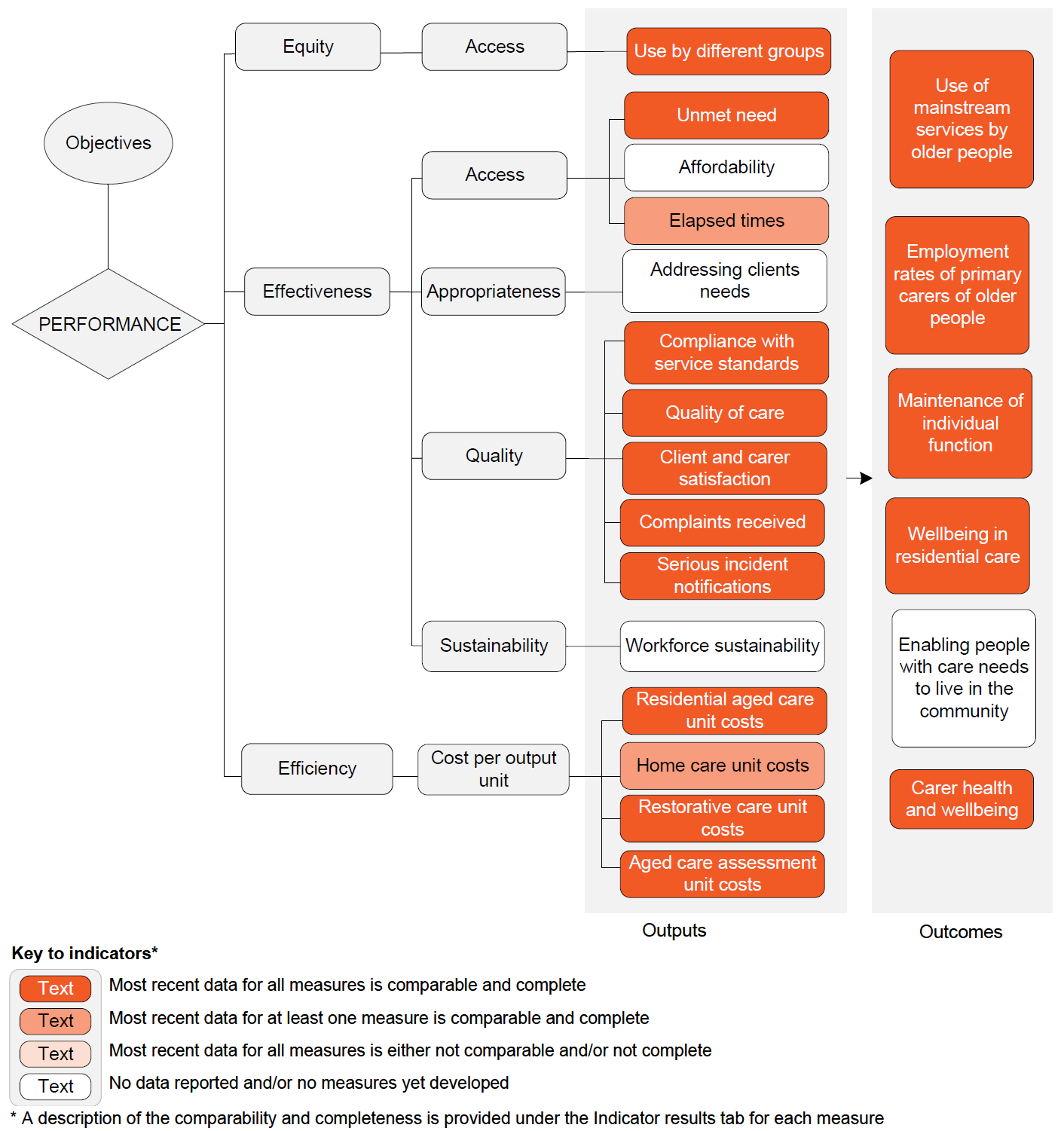
Performance – linked to Objectives
Outputs
Equity – Access
- Use by different groups – most recent data for all measures is comparable and complete
Effectiveness – Access
- Unmet need – most recent data for all measures is comparable and complete
- Affordability – no data reported and/or no measures yet developed
- Elapsed times – most recent data for at least one measure is comparable and complete
Effectiveness – Appropriateness
- Addressing client needs – no data reported and/or no measures yet developed
Effectiveness – Quality
- Compliance with service standards – most recent data for all measures is comparable and complete
- Quality of care – most recent data for all measures is comparable and complete
- Client and carer satisfaction – most recent data for all measures is comparable and complete
- Complaints received – most recent data for all measures is comparable and complete
- Serious incident notifications – most recent data for all measures is comparable and complete
Effectiveness – Sustainability
- Workforce sustainability– no data reported and/or no measures yet developed
Efficiency – Cost per output unit
- Residential aged care unit costs – most recent data for all measures is comparable and complete
- Home care unit costs – most recent data for at least one measure is comparable and complete
- Restorative care unit costs – most recent data for all measures is comparable and complete
- Aged care assessment unit costs – most recent data for all measures is comparable and complete
Outcomes
- Use of mainstream services by older people – most recent data for all measures is comparable and complete
- Employment rates of primary carers of older people – most recent data for all measures is comparable and complete
- Maintenance of individual function – most recent data for all measures is comparable and complete
- Wellbeing in residential care – most recent data for all measures is comparable and complete
- Enabling people with care needs to live in the community – no data reported and/or no measures yet developed
- Carer health and wellbeing – most recent data for all measures is comparable and complete
A description of the comparability and completeness is provided under the Indicator results tab for each measure.
This section presents an overview of 'Aged care services' performance indicator results. Different delivery contexts, locations and types of clients can affect the equity, effectiveness and efficiency of aged care services.
Information to assist the interpretation of this data can be found with the indicators below and all data (footnotes and data sources) is available for download above as an excel spreadsheet and as a CSV dataset. Data tables are identified by a '14A' prefix (for example, table 14A.1).
Specific data used in figures can be downloaded by clicking in the figure area, navigating to the bottom of the visualisation to the grey toolbar, clicking on the 'Download' icon and selecting 'Data' from the menu. Selecting 'PDF' or 'Powerpoint' from the 'Download' menu will download a static view of the performance indicator results.
‘Use by different groups’ is an indicator of governments’ objective to subsidise aged care services in an equitable manner. ‘Use by different groups’ is defined as the proportion of service clients from a selected equity group, compared with the proportion of the aged care target population from that selected equity group.
Data is reported for three selected equity groups: Aboriginal and Torres Strait Islander people; people from Culturally and Linguistically Diverse (CALD) backgrounds; and people receiving aged care services in outer regional, remote/very remote areas.
Contextual data on the proportion of all permanent residents’ care days used by financially disadvantaged residents, aged care assessment, ACAT approvals, and recommended location of longer-term living arrangements can be found in tables 14A.19-23.
The proportion of service clients from a particular selected equity group should be broadly similar to the proportion of the aged care target population from that selected equity group.
Several factors should be considered when interpreting this data.
- Selected equity groups may have greater need for aged care services.
- Cultural differences and the availability of care and support from family, friends and neighbours can also affect the use of services across different population groups.
Differences in the representation of a selected equity group in services compared to their representation in the aged care target population varied across service types and groups. Nationally in 2023-24:
- Aboriginal and Torres Strait Islander people were underrepresented in all service types but less so for Home Care Packages
- people from CALD backgrounds were overrepresented among people accessing Home Care Packages and the Aged Care Assessment Program but underrepresented in all other service types
- people receiving aged care services in rural and remote areas were underrepresented in all service types except the Commonwealth Home Support Program (CHSP) in which they were overrepresented and the Aged Care Assessment Program in which their representation was largely consistent with their representation in the community.
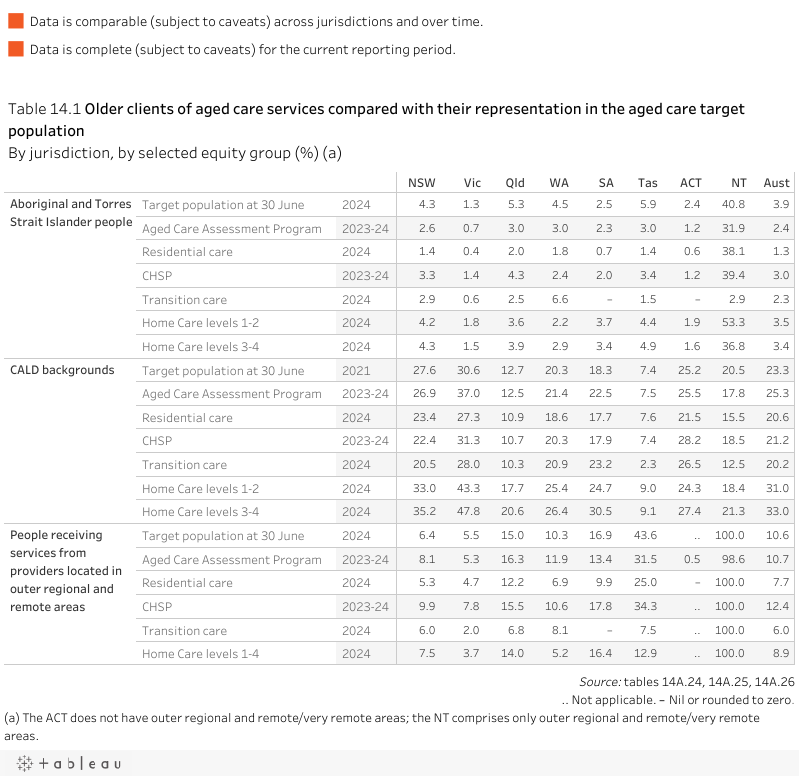
‘Unmet need’ is an indicator of governments’ objective to subsidise aged care services that are accessible. ‘Unmet need’ measures aged care service access relative to need and is defined by two measures:
- unmet need in the community
- hospital patient days used by aged care type patients.
Unmet need in the community
'Unmet need in the community' reports on the:
- Proportion of people (aged 65 years and over) living in households who need more formal assistance than they currently receive.
- Proportion of carers (of people aged 65 years and over) who report a need for further assistance in their caring roles.
- Proportion of carers who report that they and the person or people they care for had poor access to adequate levels of formal support to ensure their wellbeing.
- Proportion of carers who report high barriers when trying to access services such as in-home support, respite care, and cleaning services on behalf of a care recipient.
A low or decreasing proportion of people who report needing more formal assistance is desirable.
Data for the Northern Territory should be interpreted with caution as the ABS Survey of Disability, Ageing and Carers excludes very remote areas, which comprise more than 20% of the estimated resident population in the Northern Territory living in private dwellings.
Nationally, in 2022, 15.4% of people aged 65 years and over need more formal assistance than they currently receive, higher than in 2018 (9.7%) and 2015 (8.3%).
Nationally, in 2022, 31.3% of primary carers of people aged 65 years and over need more formal assistance than they currently receive, higher than in 2018 (25.1%) and 2015 (22.5%).
Nationally, in 2023-24, 36.3% of carers of people aged 65 years and older reported poor access to support from a formal service for in-home care and assistance with specific needs, higher than in 2022-23 (35.9%) but lower than 2021-22 (39.2%) (table 14A.29).
Nationally, in 2023-24, carers of people aged 65 years and over reported a range of barriers to accessing services, including poor service co-ordination (28.8%), lack of service availability (38.8%) and long waiting times (45.4%). The proportion of carers reporting poor service co-ordination as a barrier to access has decreased over the available time series (34.7% in 2021-22), but the proportion of carers reporting lack of service availability and long waiting times as barriers to accessing services have not significantly improved (38.7% and 43.3%, respectively, in 2021-22).
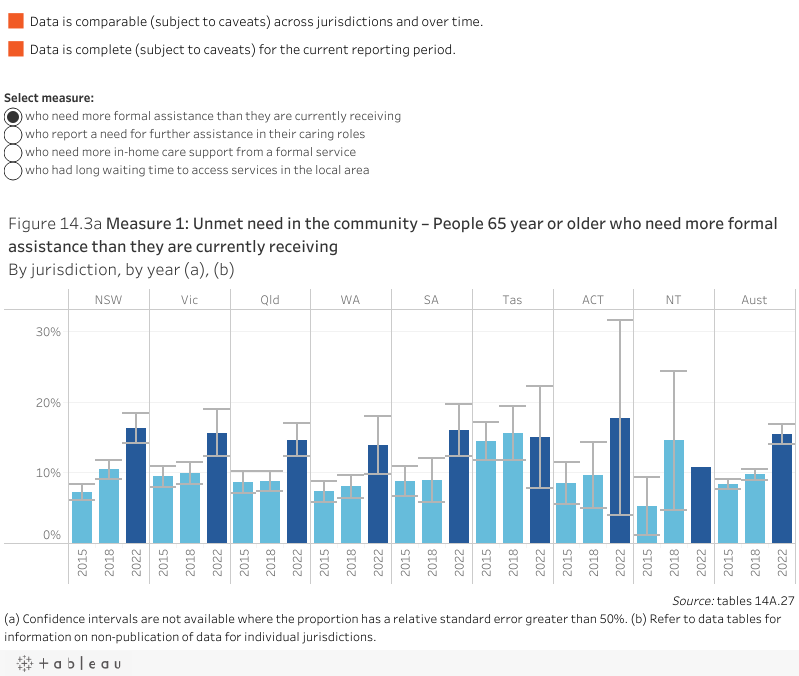
Hospital patient days used by aged care type patients
‘Hospital patient days used by aged care type patients’ is a proxy measure of unmet need defined as the proportion of hospital patient days (for overnight separations only) that were for aged care type patients (refer to 'Explanatory material' tab for further details).
Hospital inpatient services are geared towards shorter periods of acute care aimed at addressing serious illness or injury, or diagnosis. The needs of older people for maintenance care (particularly for extended periods of time) can be better met in residential aged care services than hospitals.
Understanding the relationship between the aged care and health systems is important as interactions are critical for the performance of both systems. The number of operational residential aged care places can affect demand for public hospital beds, just as the number of older patients in acute and subacute care and the time they spend in hospital can affect demand for aged care services.
A low or decreasing proportion of patient days used by aged care type patients is desirable.
This data should be interpreted with caution, because:
- days for patients who have not completed their period of care in a hospital are not included
- identification in hospital as an aged care patient type may not reflect a person’s eligibility for residential care services (this is determined by an ACAT assessment) or reliably reflect access issues for residential aged care from the acute care sector – linked ACAT and hospital separations data is not available at this time
- the diagnosis codes for aged care patient type may not be applied consistently across jurisdictions or over time
- the denominator (all patient days for overnight separations) does not directly reflect the need for aged care services
- the scope of aged care type patients differs slightly to the equivalent National Healthcare Agreement indicator (refer to table 14A.30 for details).
Nationally in 2022‑23, the rate of all hospital patient days used by patients waiting for residential aged care was 13.2 per 1,000 patient days (figure 14.3b). Rates were lower for Aboriginal and Torres Strait Islander people compared to other Australians but higher for people from lower compared to higher socioeconomic areas and for people in remote compared to non‑remote areas (table 14A.31). The proportion of separations for ‘aged care type’ patients waiting 35 days or longer was 15.0% nationally in 2022-23, the highest proportion in ten years (table 14A.30).
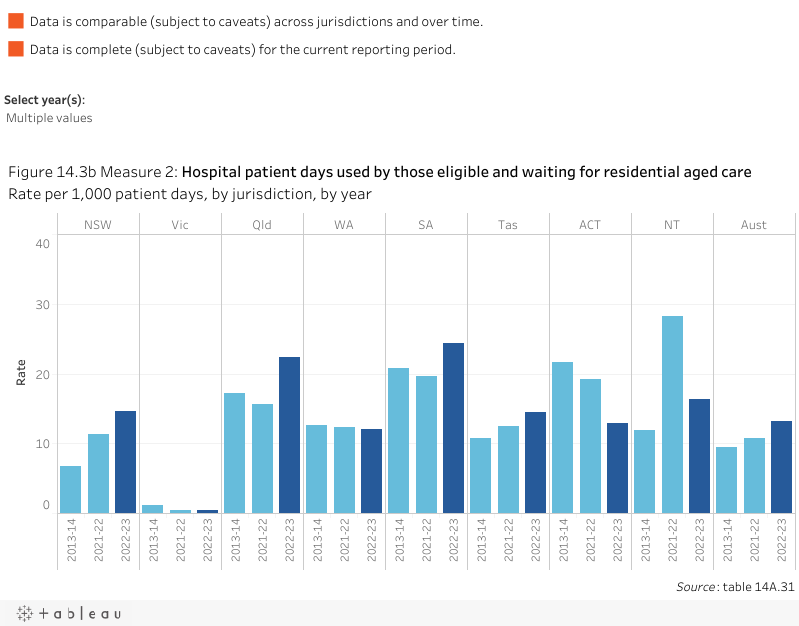
‘Affordability’ is an indicator of governments’ objective to subsidise aged care services to improve affordability for people who need them. ‘Affordability’ is defined as out‑of‑pocket costs for aged care services (after subsidies), as a proportion of disposable income.
Low or decreasing out‑of‑pocket cost for aged care services as a proportion of disposable income represents more affordable aged care services and is desirable.
Data is not yet available for reporting on this indicator.
‘Elapsed times’ is an indicator of governments’ objective to subsidise aged care services that are accessible. ‘Elapsed times’ are measured in days at the 50th and 90th percentile and reported separately for three measures:
- aged care assessment times
- home care elapsed times
- residential aged care elapsed times.
Low and decreasing days waited are desirable. However, various factors can influence days waited, including system capacity to assess applications and allocate packages, consumer choices, and market/provider supply side factors.
Days waited at the 50th percentile means half the sample will have a shorter elapsed time than this figure and half will have a longer elapsed time. Days waited at the 90th percentile means 90% of the sample will have a shorter elapsed time, while 10% will have a longer elapsed time.
Aged care assessment times
Aged care assessment times are measured in days at the 50th and 90th percentile between referral for an aged care assessment and ACAT approval (excluding incomplete assessments).
Nationally, in 2023-24, 50% of older people who were referred for an aged care assessment waited up to 22 days to receive an ACAT approval (increasing to 138 days at the 90th percentile). Days waited between referral and ACAT approval have increased from 43 days at the 90th percentile in 2020-21.

Home care packages
Home care elapsed times are measured in days at the 50th and 90th percentile between: (1) ACAT approval and the assignment of a home care package; (2) assignment of a home care package to service commencement date; and (3) ACAT approval to service commencement date. Results are reported for medium, high and all priority older people.
Results measure days between ACAT approval to assignment of a home care package and service commencement for any home care package level, whether or not it was at the approved level. Results are also limited to the first time an older person is assigned a home care package and/or services commence for an older person, as this is most indicative of the typical experience; package upgrades and opt back-ins would inflate reported elapsed times.
Nationally in 2023-24, all priority groups waited 78 days at the 50th percentile and 216 days at the 90th percentile to be assigned a home care package following ACAT approval. The elapsed time has decreased from 247 days at the 50th percentile and 335 days at the 90th percentile in 2017-18. Days waited were shorter for high-priority clients (11 days and 13 days at the 50th and 90th percentiles, respectively).
Nationally in 2023-24, all priority groups waited 118 days at the 50th percentile and 250 days at the 90th percentile for services to commence after ACAT approval. The number of days waited has decreased from 281 days at the 50th percentile and 381 days at the 90th percentile in 2017-18. Days waited were shorter for high-priority clients (40 days and 76 days at the 50th and 90th percentiles, respectively).

Residential aged care
Residential aged care elapsed times are measured in days at the 50th and 90th percentile between ACAT approval and residential aged care entry for all permanent residents and for a high priority cohort, defined as older people who enter residential aged care within 12 months of application (on the basis that older people with higher needs are unlikely to delay care entry by choice).
Not everyone assessed by an ACAT is approved for care, and some people are approved for more than one type of care. Additionally, care approvals do not lapse, which means assessments performed some years previously can be used for entry into residential aged care. With no central register of residential care offers, it is unclear if older people were offered a place and decided to delay their entry into care. Also, as an assessment can be for more than one type of care, older people can receive a home care package before they enter residential aged care.
Tables 14A.35 and 14A.36 provide information on all older people who entered into residential aged care. Tables 14A.37 to 14A.39 provide detailed information on people who entered residential aged care by equity groups.
Nationally, in 2023-24, permanent residents who entered care during the financial year and within one year of ACAT approval had an elapsed time of 68 days at the 50th percentile and 253 days at the 90th percentile (a largely consistent trend over the time series). Of all people admitted to residential care with known elapsed times in 2023-24, 67.2% were admitted within one year of ACAT approval (table 14A.35).

Nationally, in 2023-24, 41.7% of older people entered residential aged care within 3 months of their ACAT approval (figure 14.4d); the median elapsed time was 136 days, a decrease from a ten year high of 163 days in 2020-21 (table 14A.36). Nationally, the median elapsed time between ACAT approval and entry into aged care services increased by 100%, between 2014-15 and 2023-24.
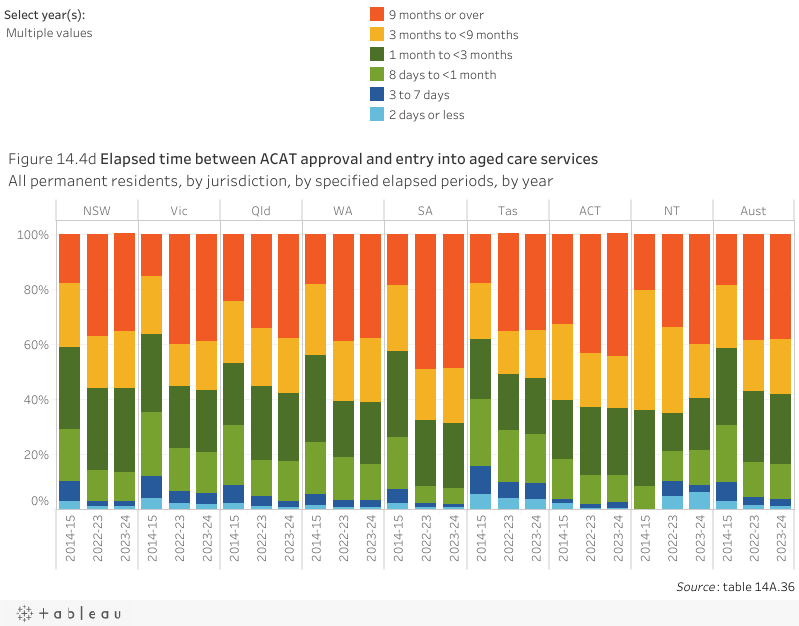
‘Addressing client needs’ is an indicator of governments’ objective to subsidise aged care services that are appropriate to meet the needs of clients – person‑centred, with an emphasis on integrated care, ageing in place and restorative approaches.
‘Addressing client needs’ will measure the extent to which:
- care recipients or their representatives had input into the planning of their care
- the supports identified in the care planning process to address an individual’s needs were provided (match of needs)
- individual interests, customs, beliefs and cultural and ethnic backgrounds were valued and fostered.
Data is not yet available for reporting on this indicator.
‘Compliance with service standards’ is an indicator of governments’ objective to subsidise high quality aged care services. 'Compliance with service standards' measures the extent to which approved aged care services (residential and home care) are meeting expected standards and is defined by three measures:
- Re-accreditation of residential aged care providers
- Compliance with aged care quality standards
- Compliance with care minutes and registered nurse requirements.
Residential care – re-accreditation
This measure reports the proportion of accredited services given three‑year re-accreditation. Three years is the longest period for which re‑accreditation can be granted (in most cases). If a service is re‑accredited for this period, it implies a higher level of service quality than services re‑accredited for a shorter period. Further information on the accreditation standards and process is available at http://www.agedcarequality.gov.au.
Data for this measure does not include new services (0.5% of all residential care services) that have not been re‑accredited as at 30 June 2024 (table 14A.43).
High or increasing proportions of services that are re‑accredited for three years are desirable.
Information on re-accreditation by the size of the facility (places) and location can be found in tables 14A.41-42.
During 2023‑24, 92.3% of the 662 services re‑accredited that year were given three-year accreditation status; up from 85.0% in 2021‑22 (table 14A.40). At 30 June 2024, 92.7% of all 2,792 re-accredited residential aged care services had been given three-year accreditation. This is the highest value since 30 June 2018, but is still significantly lower than a peak of 98.3% in 2016 (figure14.5a and table 14A.43).

Compliance with Aged Care Quality Standards
On 1 July 2019, the Aged Care Quality Standards took effect for organisations providing all types of Commonwealth‑subsidised aged care services. These standards are:
- Standard 1 – Consumer dignity and choice
- Standard 2 – Ongoing assessment and planning with consumers
- Standard 3 – Personal care and clinical care
- Standard 4 – Services and supports for daily living
- Standard 5 – Organisation’s service environment
- Standard 6 – Feedback and complaints
- Standard 7 – Human resources
- Standard 8 – Organisational governance.
High or increasing proportions of services that met all expected outcomes are desirable.
For Australian Government subsidised aged care services, 21.7% of services received a re-accreditation audit during 2023-24 for residential aged care services, and 30.1% received a quality audit for home care and support (table 14A.44). The proportions of residential aged care and home care and home support service providers reviewed during 2023‑24 that achieved the standards are in table 14.2.
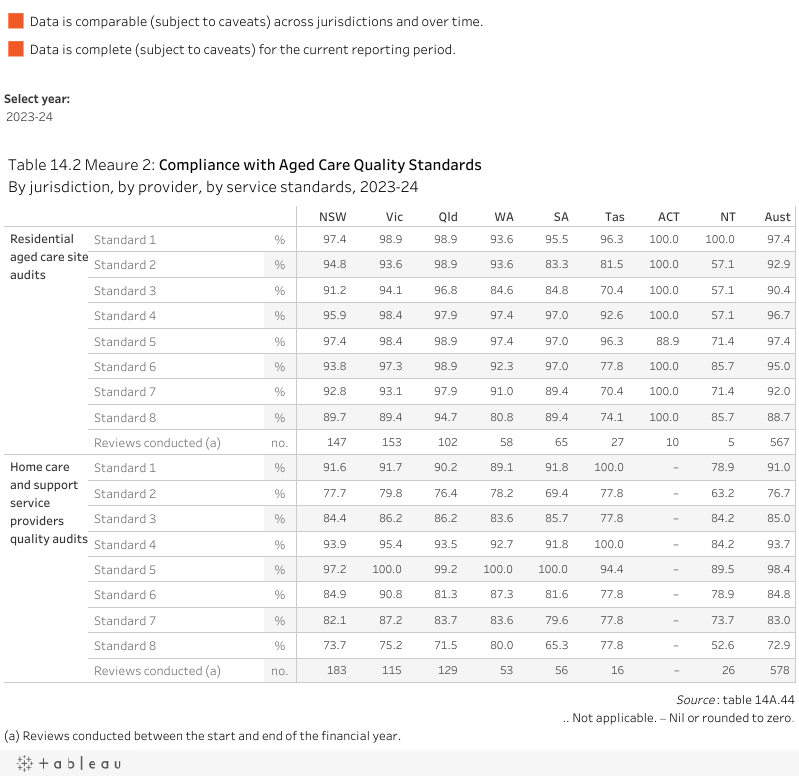
Compliance with care minutes requirements
For the first time, this report includes information on the extent to which residential care services comply with care minutes targets.
The care minutes responsibility requires approved residential aged care service providers to provide residents with a minimum amount of direct care time by registered nurses (RN), enrolled nurses, and personal care workers and assistants. The sector-wide care minutes benchmark for the 2023-24 financial year was an average of 200 minutes per resident per day, including 40 minutes of RN time.
Compliance with care minutes is measured as the proportion of services that met both the total care minutes target and the RN care minutes target. Information on the proportion of services that separately met these targets is available in table 14A.45.
A high or increasing proportion of services that meet their care minutes targets is desirable.
Nationally, in 2023-24, 34.0% of residential aged care services met both the total care minutes target and the RN care minutes target (separately, 52.0% of residential aged care services met the total care minutes target and 50.5% met the RN care minutes target) (table 14A.45).
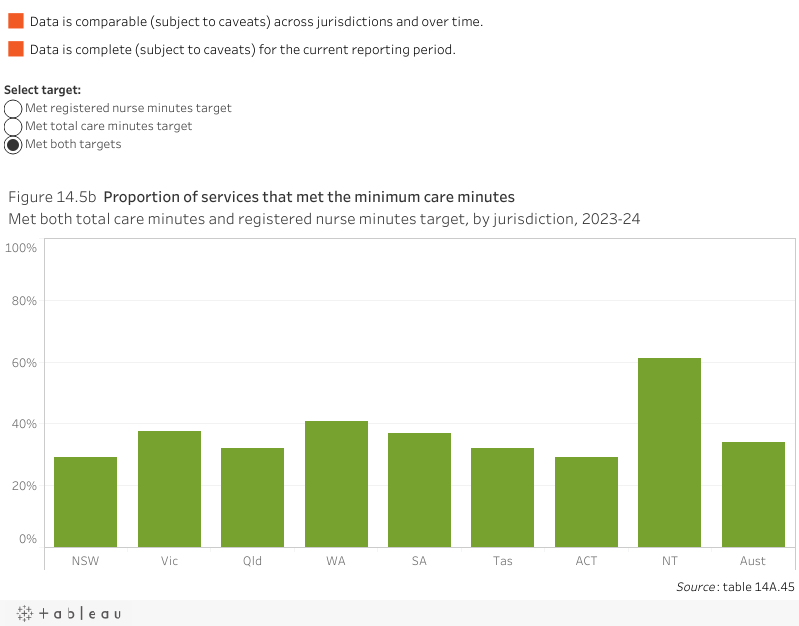
Registered nurse (RN) 24/7 coverage requirements
For the first time, this report includes information on the extent to which residential care services comply with 24/7 RN coverage requirements. The 24/7 RN coverage responsibility requires approved providers of residential care services in a residential facility to ensure at least one RN is on-site and on duty 24 hours a day, 7 days a week at the residential facility.
Compliance with the 24/7 RN coverage requirement is measured as the proportion of facilities with an RN on-site and on duty 24 hours a day, seven days a week. A high or increasing percentage of services meeting their 24/7 RN coverage requirements is desirable.
Nationally, in 2023-24, 89.3% of residential aged care services met the 24/7 RN coverage requirement with an RN on-site and on-duty 24 hours a day, seven days a week (table 14A.46).
‘Quality of care’ is an indicator of governments’ objective to subsidise high quality aged care services. High quality aged care services provide services that meet residents’ personal, functional, clinical and psycho-social needs to a high standard.
‘Quality of care’ in residential aged care services is measured according to the expanded National Aged Care Mandatory Quality Indicator Program (the QI program). Participation in the QI program has been a requirement for all Australian Government subsidised residential aged care services since 1 July 2019.
The definitions and data collection methods for each quality indicator are outlined in the QI Program Manual 3.0 – Part A (Department of Health and Aged Care, 2023) https://www.health.gov.au/resources/publications/national-aged-care-mandatory-quality-indicator-program-manual-30-part-a.
‘Quality of care’ is defined by eight measures:
- pressure injuries
- physical restraint
- medication management
- falls
- weight loss
- activities of daily living
- incontinence care
- hospitalisation.
Tables 14A.52-54 contain the results for the measures of activities of daily living (% of care recipients who experienced a decline in activities of daily living), incontinence care (% of care recipients who experienced incontinence-associated dermatitis), hospitalisation (% of care recipients who presented to emergency departments and were admitted to hospitals).
Further details on the definitions of these measures are available in the Key Terms section.
All else being equal, a low or decreasing rate of physical restraint, unplanned weight loss, falls, medication management issues, deterioration in activities of daily living and incontinence care issues can suggest higher-quality services. However, high or increasing occurrences might reflect more effective reporting and monitoring arrangements.
Data for the Northern Territory should be interpreted with caution due to the small number of residential aged care services in the territory.
Pressure injuries – care recipients were observed for pressure injury once each quarter during 2023-24. In quarter 4 (Q4; April to June 2024), 5.4% of care recipients had one or more pressure injuries, down from the same quarter in 2021-22 (6.3%). Prevalence was higher for lower grade pressure injuries (table 14A.47).
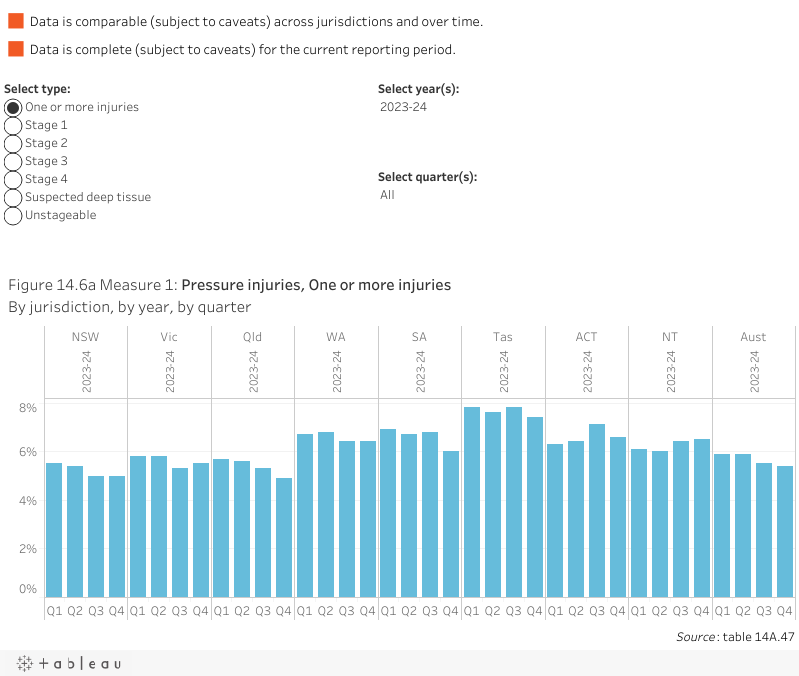
Physical restraint – the use of physical restraint was assessed by reviewing three days of existing care records each quarter during 2023-24. In quarter 4 (Q4; April to June 2024), 18.5% of care recipients experienced physical restraint, and 14.4% were restrained exclusively through the use of a secure area, down from the same quarter in 2021-22 (21.6% and 17.1%) (table 14A.48). Please refer to the Key terms for more information on what type of restraints are included in physical restraint.

Unplanned weight loss – assessment of care recipients’ weight loss occurred monthly, however both unplanned weight loss indicators were measured on a quarterly basis during 2023-24. In quarter 4 (Q4; April to June 2024), 7.1% of care recipients experienced significant unplanned weight loss (meaning unplanned weight loss of 5.0% or more when comparing their current and previous quarter finishing weights), and 7.1% of care recipients experienced consecutive unplanned weight loss (meaning consecutive unplanned weight loss every month over three consecutive months of the quarter) down from the same quarter in 2021-22 (9.4% for both measures) (table 14A.49).
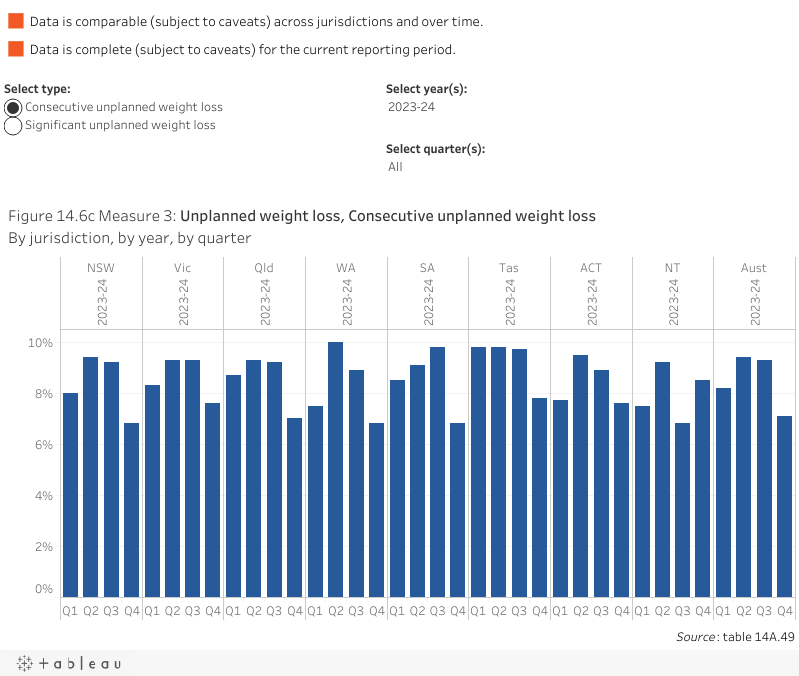
Falls and major injury – falls and falls resulting in major injury were assessed by reviewing care records over the entire quarter for each quarter during 2023-24. In quarter 4 (Q4; April to June 2024), 32.6% of care recipients experienced a fall, with 1.8% resulting in major injury (for example, bone fractures, joint dislocations, and head injuries), stable compared to the same quarter in 2021-22 for care recipients who experienced a fall (32.2%) but a decrease in care recipients who experienced a fall resulting in major injury (2.2%) (table 14A.50).
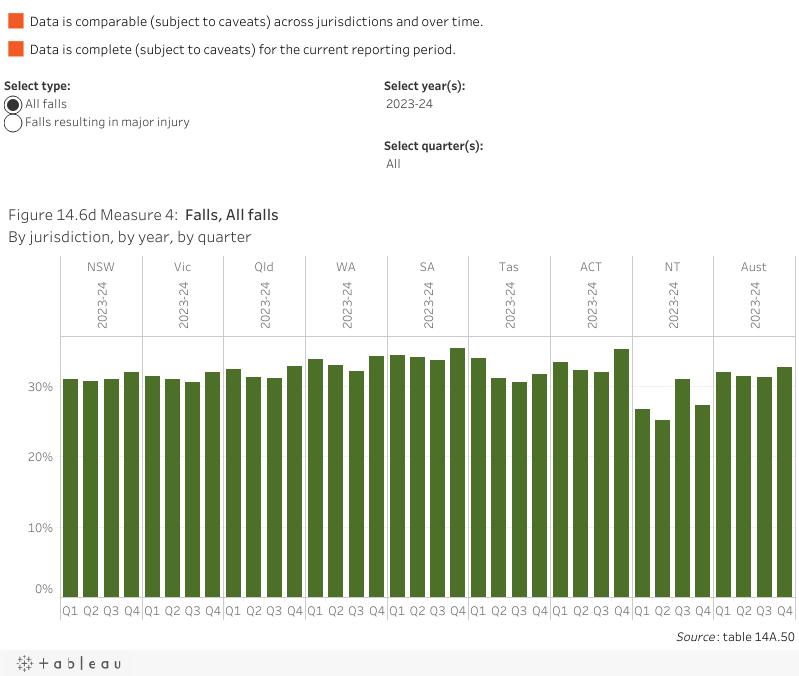
Medication management – care recipients' medication charts and/or records were assessed through a single review each quarter during 2023-24. In quarter 4 (Q4; April to June 2024), 34.3% of care recipients were prescribed nine or more medications, down compared to the same quarter in 2021-22 (37.5%). In Q4, 8.8% of all care recipients received antipsychotic medications for a diagnosed condition of psychosis, although 17.7% of all care recipients received antipsychotic medications, down from the same quarter in 2021-22 (10.7% and 19.7%) (table 14A.51).
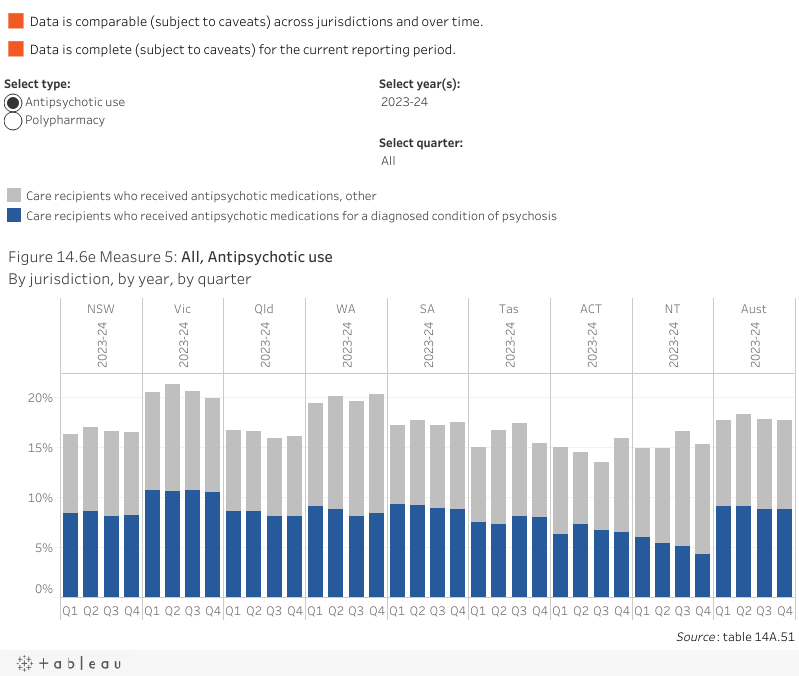
National Aged Care Mandatory Quality Indicator Program data used to report on this indicator are based on quarterly assessment data recorded by service as distinct from care recipients. Therefore, it is not possible to determine the number of quarters in which the same care recipients were assessed.
‘Client and carer satisfaction’ is an indicator of governments' objective to subsidise high quality aged care services. ‘Client and carer satisfaction’ is defined by six measures:
- Proportion of people aged 65 years or over living in households, who are satisfied with the range of formal service options available
- Proportion of people aged 65 years or over living in households, who are satisfied with the quality of assistance received from formal services in the last six months
- Proportion of primary carers living in households (caring for people aged 65 years or over), who are satisfied with the range of formal service options available to help them in their caring role
- Proportion of primary carers living in households (caring for people aged 65 years or over), who are satisfied with the quality of assistance received from formal services in the last six months to help them in their caring role
- Proportion of carers who reported high satisfaction with their access to support (respite care services)
- Proportion of consumers of residential aged care who reported 'good' or 'excellent' consumer experiences.
Performance indicator 7 'Quality of care' presents information on the QI program, which includes consumer experience.
A high or increasing proportion of clients and carers who are satisfied is desirable as it suggests that the service received was of a higher quality.
Data for the Northern Territory should be interpreted with caution as the ABS Survey of Disability, Ageing and Carers excludes very remote areas which comprises more than 20% of the estimated resident population in the Northern Territory living in private dwellings and due to the small number of residential aged care services in the territory.
Nationally, in 2022, 63.0% of people aged 65 years and over who reported a need for or received formal services in the previous six months were satisfied with the range of services available (table 14A.55).
Nationally, in 2022, 85.4% of people aged 65 years and over who received formal services in the previous six months were satisfied with the quality of assistance they received (table 14A.56).
For primary carers of people aged 65 years and over, the proportion who were satisfied with the range of organised services available to help them in their caring role was 36.3% in 2022, a decrease of around 10 percentage points from 2015 and 2012 (table 14A.57).
For primary carers of people aged 65 years and over, the proportion who were satisfied with the quality of assistance provided to help them in their caring role was 63.6%, down from 84.7% in 2012 (table 14A.58).
Nationally, the proportion of carers who were satisfied with their access to respite care services was 41.2% in 2023-24, a consistent trend over time (figure 15.7b; table 14A.59).
The proportion of care recipients who completed the consumer experience survey and reported a good or excellent consumer experience using all methods in quarter 4 (Q4; April to June 2024) was 82.5%. Proportions varied by completion method (table 14A.60).
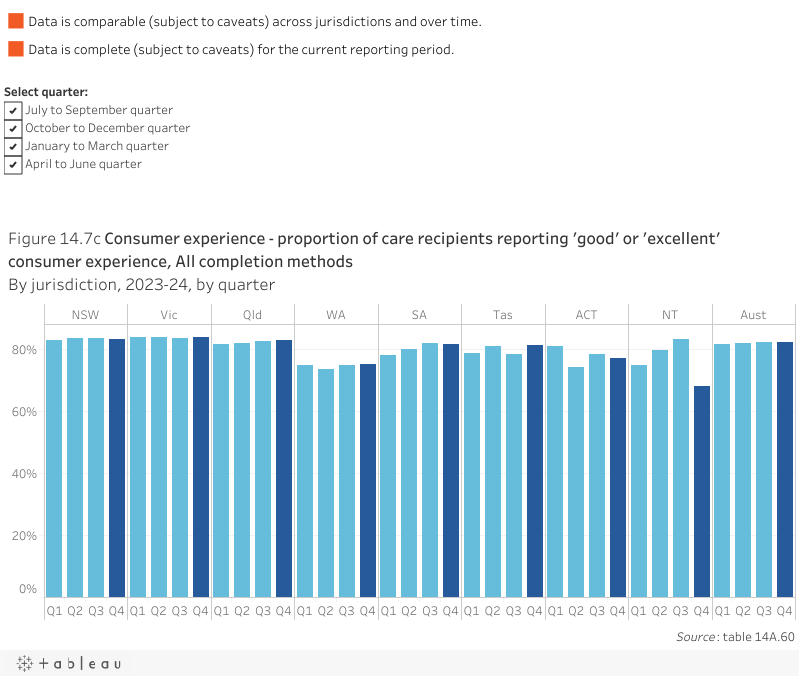
‘Complaints received’ is an indicator of governments’ objective to subsidise high quality aged care services. ‘Complaints received’ is defined as the number of in‑scope complaints received by the Aged Care Quality and Safety Commission that relate to Australian Government funded providers of residential care, home care, CHSP or flexible aged care services. However, the reported rate of complaints (complaints per 10,000 occupied bed days) is for complaints about residential aged care services only.
All else being equal, a low or decreasing rate of complaints can suggest higher quality services. However, a high or increasing rate of complaints may not necessarily mean lower quality services. It may reflect more effective complaints reporting and monitoring arrangements.
Nationally, in 2023‑24, the Aged Care Quality and Safety Commission received 9,559 in‑scope complaints. Of these, 5,424 concerned permanent and respite residential aged care services, equivalent to 0.76 complaints per 10,000 occupied bed days, a decrease from a peak of 0.93 in 2021-22 (figure 14.8).
‘Serious incident notifications’ is an indicator of governments’ objective to subsidise high quality aged care services. 'Serious incident notifications' is defined by two measures:
- the number of Serious Incident Response Scheme notifications received by the Aged Care Quality and Safety Commission, by primary incident type, per 10,000 occupied bed days in residential care
- the number of Serious Incident Response Scheme notifications received by the Aged Care Quality and Safety Commission, by primary incident type in-home care.
The Serious Incident Response Scheme (the Scheme) was introduced on 1 April 2021. The purpose of the Scheme is to help prevent and reduce incidents of abuse and neglect in residential aged care services subsidised by the Australian Government. The Scheme was extended to aged care services delivered in home or community settings on 1 December 2022.
In a mature system where providers are routinely complying with reporting obligations, low or decreasing rates of Serious incident notifications are desirable. However, high or increasing rates might reflect more effective incident reporting mechanisms and organisational cultural change.
The number of Serious Incident Response Scheme notifications does not necessarily correlate to the number of instances of harm to an older person in aged care. Reports might include multiple notifications of the same matter, allegations of incidents, and situations where incidents occurred but injury was avoided. Incident rates should be monitored over time to identify trends.
Nationally, in 2023-24, the Aged Care Quality and Safety Commission received 55,048 Serious Incident Response Scheme notifications from residential aged care service providers, which equates to 7.7 notifications per 10,000 occupied bed days (an increase from 5.5 notifications per 10,000 occupied bed days in 2021-22, which was the first full year of the scheme) (figure 14.9a). Notifications most commonly concerned the unreasonable use of force (table 14A.62).
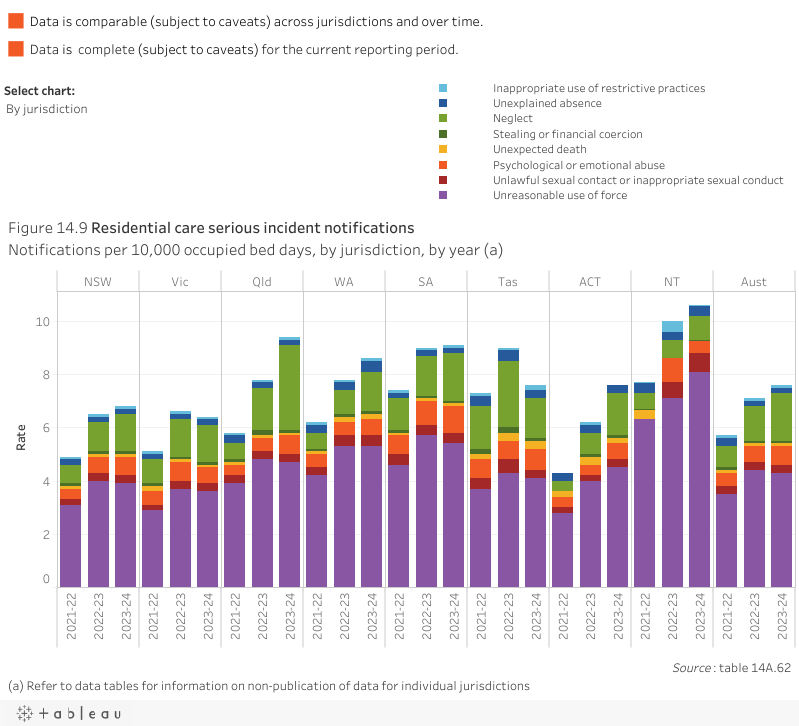
Nationally, in 2023-24, the Aged Care Quality and Safety Commission received 4,879 Serious Incident Response Scheme notifications from in-home care service providers. Notifications most commonly concerned neglect (table 14A.63).
‘Workforce sustainability’ is an indicator of governments’ objective to provide sustainable aged care services.
Aged care workforce sustainability relates to the capacity of the aged care workforce to meet current and projected future service demand. These measures are not a substitute for a full workforce analysis that allows for training, migration, changing work patterns and expected future demand. They can, however, indicate that further attention should be given to workforce planning for aged care services.
This indicator is under development. Table 14A.64 presents contextual data on workforce turnover in residential aged care services. This data provides insights into provider turnover, but it does not provide a comprehensive picture of workforce sustainability. For example, rather than leaving the sector, a worker might have moved to a new service provider, and therefore, the effect on overall workforce sustainability is unknown.
Of all staff, 5.1% stopped working at a provider during quarter 4 (Q4; April to June 2024). The proportion was highest for nurse practitioners or registered nurses (7.0%).
‘Residential aged care unit costs’ is an indicator of governments’ objective to subsidise aged care services in an efficient manner. ‘Residential aged care unit costs’ is defined by two measures:
- Average annual program cost, per occupied bed day – real annualised government expenditure on residential aged care services.
- Average annual Australian Government residential aged care subsidy (all levels of care), per claim day – real annualised subsidy entitlements plus Conditional Adjustment Payment (CAP).
For measure 1, annualised costs are derived using total government aged care program expenditure on residential aged care services (Australian Government Department of Health and Aged Care, Department of Veterans' Affairs, and state and territory government supplements), divided by the number of occupied bed days, multiplied by 365 to present an average cost figure for an aged care resident in care for a year.
For measure 2, annualised costs are derived using total Australian Government aged care subsidy claims, divided by the number of claim days, multiplied by 365 to present an average subsidy amount that aged care providers could have claimed for an aged care resident in care for a year.
While high or increasing residential aged care unit costs might reflect deteriorating efficiency, it might also reflect changes in aspects of the service (such as greater time spent with clients) or differences in the characteristics of clients (such as their geographic location or higher levels of acuity). Similarly, while low or declining residential aged care unit costs might reflect improving efficiency, it might also reflect declining quality.
Not all expenditure is included in these measures. Expenditure by local governments and non-government sources is not captured.
Nationally, in 2023-24, the average annualised cost per occupied bed day was $109,566, up from $75,486 in 2014-15 (table 14A.65 and figure 14.10).
Nationally, in 2023-24, the average annualised Australian Government subsidy per claim day was $105,157 using the new classification system, AN-ACC (table 14A.66 and figure 14.10).

‘Home care unit costs’ is an indicator of governments’ objective to subsidise aged care services in an efficient manner. ‘Home care unit costs’ is defined by four measures:
- Average annual program cost of home care – real Australian Government expenditure on the home care package programme per recipient.
- Average annualised home care package payment – real payments on home care packages to recipients.
- Expenditure per hour of service for CHSP – real Australian Government expenditure on services, divided by the number of hours of service provided.
- Average annual program cost of CHSP – real Australian Government expenditure on CHSP per client.
While high or increasing home care unit costs might reflect deteriorating efficiency, it might also reflect changes in aspects of the service (such as greater time spent with clients) or differences in the characteristics of clients (such as their geographic location). Similarly, while low or declining home care unit costs might reflect improving efficiency, it may also reflect declining quality.
Not all expenditure is included in these measures. Expenditure by local governments and non-government sources is not captured.
Nationally in 2023-24, the cost per recipient of a home care package programme was $22,585 (table 14A.67). This is an increase from $18,754 in 2022-23.
Nationally in 2023-24, the cost per recipient of the Commonwealth Home Support Programme (CHSP) was $3,580, up from $3,293 in 2017-18, although a decrease compared with 2022-23 ($3,805) (table 14A.68).
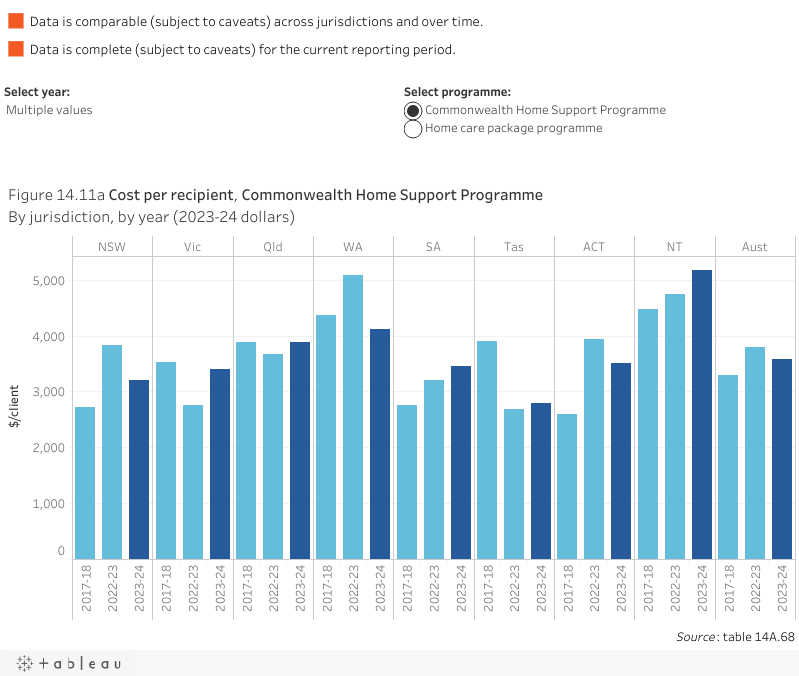
Nationally, in 2023-24, the average annualised payment per home care package was $26,700, an increase from 2022-23 ($23,480). The average annualised payment amount increased with package level ($8,100 for a level one home care package, compared to $46,900 for a level four home care package) (figure 14.11b).

Table 14A.69 includes additional contextual information on aged care package entitlement (i.e. allocated funds) and unspent funds.
Nationally, in 2023-24, expenditure per hour of service for all CHSP service types (nursing, allied health, personal care, and domestic assistance) decreased compared to 2022-23. Expenditure per hour of service was highest for nursing ($142.84), followed by allied health ($110.05), personal care ($109.71) and domestic assistance ($60.60) (figure 14.11c and 14.11d).
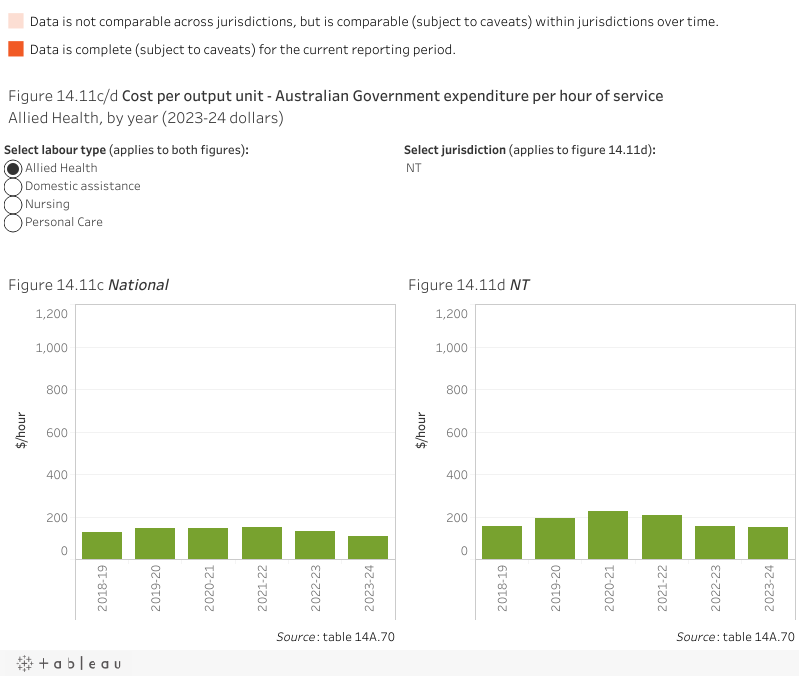
‘Restorative care unit costs’ is an indicator of governments’ objective to subsidise aged care services in an efficient manner. ‘Restorative care unit costs’ is defined by two measures:
- Transition care, real cost per recipient day
- Short-term restorative care, real cost per recipient day.
The Transition Care Programme is funded by the Australian Government and the state and territory governments, while the Short Term Restorative Care Programme is funded by the Australian Government.
While high or increasing restorative care unit costs might reflect deteriorating efficiency, it might also reflect changes in aspects of the service (such as greater time spent with clients) or differences in the characteristics of clients (such as their geographic location or entry conditions). Similarly, while low or declining restorative care unit costs might reflect improving efficiency, it might also reflect declining quality.
Not all expenditure is included in these measures. Expenditure by local governments and non-government sources on services is not captured.
Nationally, in 2023-24, the cost per day of the Transition Care Programme was $461, up from $345 in 2017-18 (table 14A.71).
Nationally, in 2023-24, the cost per day of the Short Term Restorative Care Programme was $223, up from $207 in 2021-22, the earliest year available (table 14A.71).
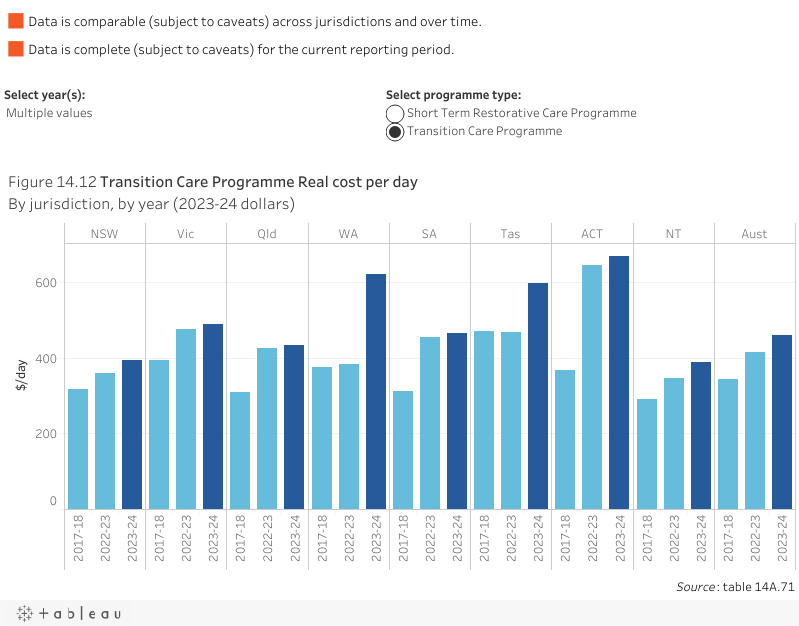
‘Aged care assessment unit costs’ is an indicator of governments’ objective to subsidise aged care services in an efficient manner. ‘Aged care assessment unit costs’ is defined by two measures:
- Australian Government expenditure per ACAT assessment – Australian Government expenditure on the Aged Care Assessment Team (ACAT) Program, divided by the number of completed assessments.
- Australian Government expenditure per RAS assessment – Australian Government expenditure on the Regional Assessment Services (RAS) program, divided by the number of completed assessments.
While high or increasing aged care assessment unit costs might reflect deteriorating efficiency, it might also reflect changes in aspects of the service (such as greater time spent with clients) or differences in the characteristics of clients (such as their geographic location). Similarly, while low or declining aged care assessment unit costs might reflect improving efficiency, it might also reflect declining quality.
Not all expenditure is included in these measures. Expenditure by local governments and non‑government sources (for example, client fees for CHSP) and state and territory governments’ contributions to the cost of ACAT assessments are not captured.
Nationally, in 2023-24, the average Australian Government expenditure per ACAT assessment was $644 down from $725 in 2014-15 (table 14A.72).
Nationally, in 2023-24, the average Australian Government expenditure per RAS assessment was $434, down from $501 in 2017-18 (table 14A.73).
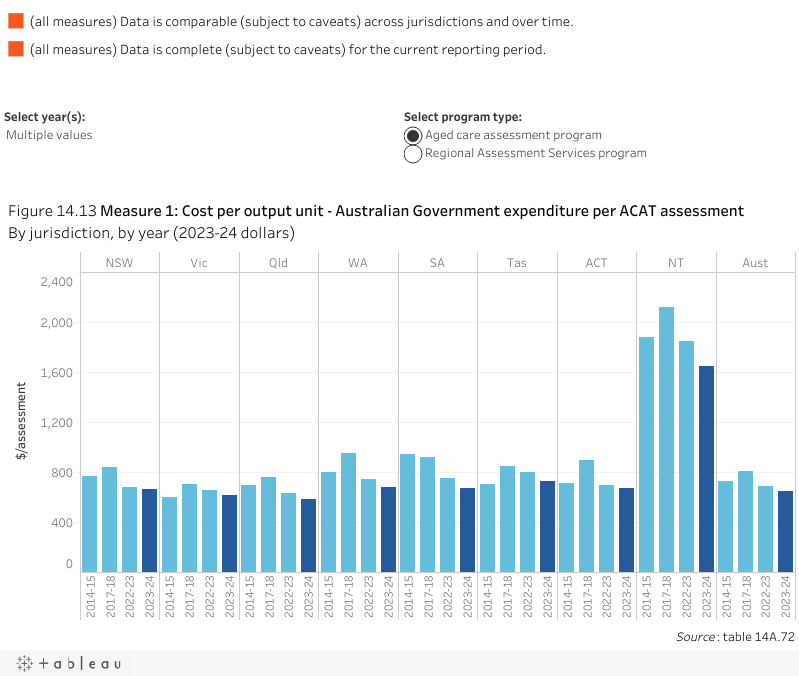
'Use of mainstream services by older people' is an indicator of governments' objective that people aged 65 years and older have an enhanced quality of life and enjoy choice and wellbeing. 'Use of mainstream services by older people' is defined as the proportion of people aged 65 years or older who reported difficulty accessing government buildings in the last 12 months.
Low or decreasing proportions of people aged 65 years and older experiencing difficulty accessing government buildings is desirable.
Data for the Northern Territory should be interpreted with caution as the ABS Survey of Disability, Ageing and Carers excludes very remote areas which comprises more than 20% of the estimated resident population in the Northern Territory living in private dwellings.
Nationally, in 2022, 4.1% of people aged 65 years and over reported difficulty accessing government buildings in the last 12 months, compared to 30.1% of people aged 65 years and over who reported difficulty accessing any facilities in the past 12 months.
'Employment rates of primary carers of older people’ is an indicator of governments' objective to help carers of people aged 65 years and over achieve economic participation. 'Employment rates of primary carers of older people' is measured as the employment rate of primary carers (aged 15-64 years) who are caring for people aged 65 years and over, compared to the general population aged 15-64 years.
Similar rates of employment for primary carers and the general population are desirable.
This indicator does not assess whether employment opportunities are appropriate or fulfilling.
Nationally, in 2022, 58.5% of primary carers (15-64 years old) caring for people aged 65 years and over were employed, compared to 77.4% of the general population aged 15-64 years. Employment rates for primary carers increased from 57.6% in 2018 and 53.8% in 2015.
‘Maintenance of individual function’ is an indicator of governments’ objective for aged care services to promote the wellbeing and independence of older people. ‘Maintenance of individual function’ is defined as improvement in the level of physical function for Transition Care Programme (TCP) and Short-Term Restorative Care Programme (STRCP) clients from entry to exit, measured as the difference between the average Modified Barthel Index (MBI) score on entry and exit. See the explanatory material for further information on the MBI.
An increase in the score from entry to exit is desirable.
This indicator needs to be interpreted with caution:
- The TCP and STRCP operate with some differences across jurisdictions, including differences in health and aged care service systems, local operating procedures and client groups. Variations in the average MBI scores on entry and exit from the program may reflect differences in client groups for the program across jurisdictions.
- The TCP is a small program only available directly on discharge from hospital (in 2023‑24 there were 14,388 admissions to the TCP) (table 14A.76). The average duration is around 10 weeks, with a maximum duration of 12 weeks (although this may be extended by a further six weeks in some circumstances).
- The STRCP provides services to older people for up to 8 weeks (56 days) to help delay or avoid long-term care (in 2023‑24, there were 9,143 admissions to the STRCP) (table 14A.77).
Nationally, in 2023‑24, the average MBI score for TCP clients increased from entry (72) to exit (83), similar to previous years (table 14A.76). Nationally, in 2023‑24, the average MBI score for STRCP clients increased from entry (82) to exit (85), similar to the previous year (table 14A.77).
'Wellbeing in residential care' is an indicator of governments' objective to promote the wellbeing of older people by assisting them in residential care and providing appropriate and high quality care to meet their needs. 'Wellbeing in residential care' is defined by two measures:
- The proportion of older people in residential aged care who report positive experiences in residential aged care, 'Always' and 'Most of the time', as measured by the Residents’ Experience Survey (RES).
- The proportion of older people in residential aged care who report having a 'good' or 'excellent' quality of life, as measured by the National Aged Care Mandatory Quality Indicator (QI) Program.
Performance indicator 7 'Quality of care' presents further information on the QI program.
A high or increasing proportion of older people in residential aged care who report positive experiences in residential aged care and a good or excellent quality of life is desirable.
Data for the Northern Territory on the proportion of older people in residential aged care who report having a 'good' or 'excellent' quality of life should be interpreted with caution due to the small number of residential aged care services in the territory.
The proportion of care recipients who completed the quality of life survey and reported a good or excellent quality of life using all methods in quarter 4 (Q4; April to June 2024) was 73.7%. Proportions varied by completion method (table 14A.79).
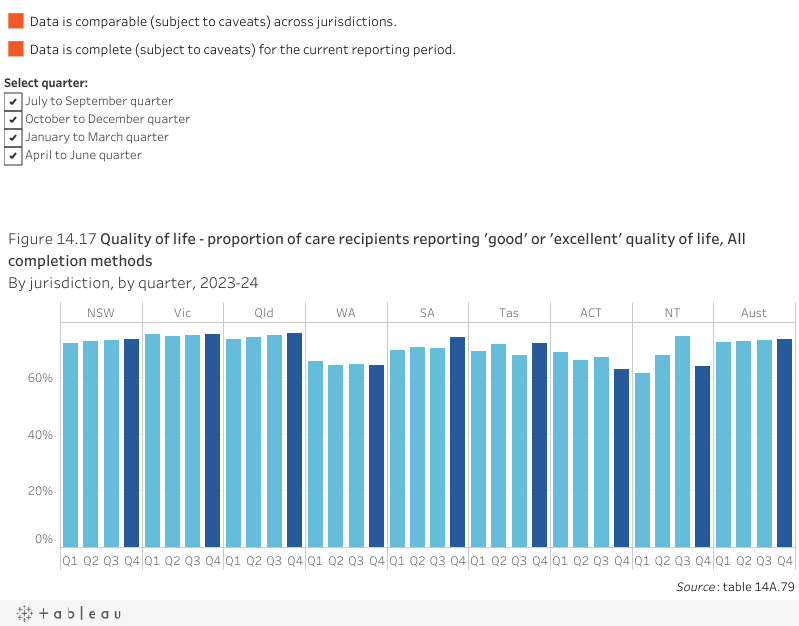
Nationally in 2023:
- 74.7% of residents reported that they always felt safe
- 70.8% of residents reported staff always treated them with respect
- 57.2% of residents reported they always received the care they need
- 58.9% of residents reported that they would always recommend their residential aged care service to others.
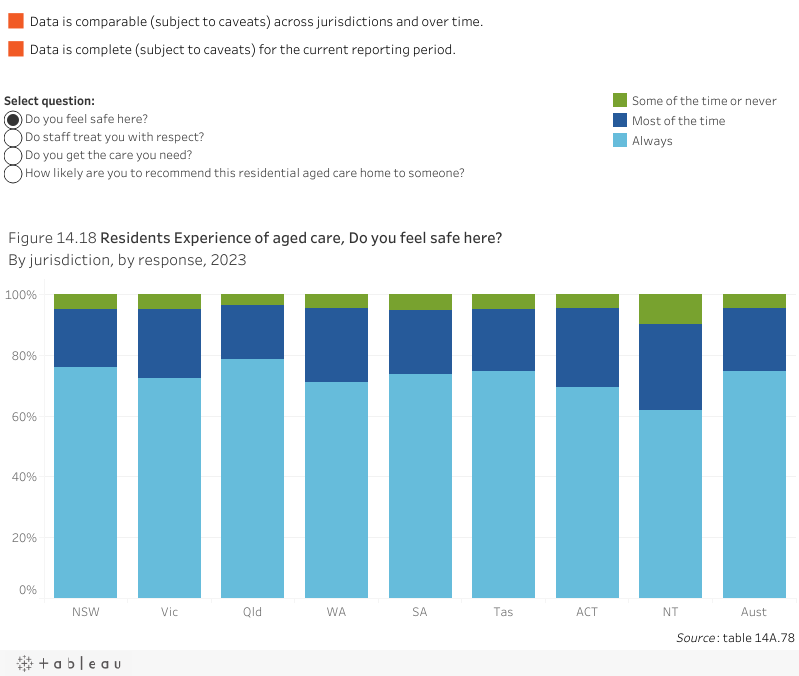
‘Enabling people with care needs to live in the community’ is an indicator of governments’ objective to promote the wellbeing and independence of older people, by enabling them to stay in their own homes.
‘Enabling people with care needs to live in the community’ is defined as the proportion of older people with care needs who are living in the community.
An increasing proportion of older people with care needs who want to and are living in the community is desirable. This indicator should be considered alongside the outcome indicator on social participation.
Data is not yet available for reporting against this indicator.
'Carer health and wellbeing' is an indicator of governments' objective that carers of people aged 65 and older have an enhanced quality of life and enjoy choice and wellbeing. 'Carer health and wellbeing' is defined by three measures, which assess the rate of:
- self-reported wellbeing of carers compared to the general population
- self-reported loneliness ('often' or 'always' experiencing loneliness) of carers compared to the general population
- self-reported health ('fair' or 'poor') of carers compared to the general population.
Similar rates of carer health and wellbeing compared to the general population is desirable.
Nationally, in 2023-24:
- 50.3% of carers reported low levels of wellbeing on the Personal Wellbeing Index compared with the general population (23.8%), and an increase from 2021-22 (48.6%)
- 34.2% of carers responded that they are often/always lonely compared with the general population (13.8%). This result is similar to 2021-22 (33.9%)
- 48.5% of carers responded that they have either fair or poor health compared with the general population (21.2%), and an increase from 2021-22 (44.3%).
Performance indicator data for Aboriginal and Torres Strait Islander people in this section is available in the data tables listed below. Further supporting information can be found in the 'Indicator results' tab and data tables.
| Table number | Table title |
|---|---|
| Table 14A.25 | Representation of Aboriginal and Torres Strait Islander people in the aged care target population and aged care recipients |
| Table 14A.31 | Hospital patient days used by those eligible and waiting for residential aged care |
| Table 14A.39 | Elapsed times for residential aged care, by Indigenous status |
| Terms | Definition |
|---|---|
| Accreditation | Accreditation is a key component of the Australian Government’s quality framework for federally funded residential aged care and is a quality assurance system for residential aged care services – based on the principle of continuous improvement. Accreditation requires assessment against the Aged Care Quality Standards ‑ grouped into eight standards: consumer dignity and choice; ongoing assessment and planning with consumers; personal care and clinical care; services and supports for daily living; service environment; feedback and complaints; human resources; and organisational governance. |
| Aged care | Services funded and/or provided by governments that respond to the functional and social needs of older people, and the needs of their carers. Home care and home support services aim to optimise independence and to assist older people to stay in their own homes, while residential care services provide accommodation and care for those who can no longer be cared for at home. Assessment of care needs is an important component of aged care. The majority of aged care services assist in activities of daily living such as personal care (for example, bathing and dressing), housekeeping and meal provision. Other services aim to promote social participation and connectedness. These services are delivered by trained aged care workers and volunteers. However, aged care services may also be delivered by health professionals such as nurses and occupational therapists. Aged care services generally aim to promote wellbeing and foster function rather than to treat illness. Although some aged care services such as transition care have a specific restorative role, they are distinguished from the health services described in Part E of this Report. Aged care services may be funded through programs specifically or mainly directed to older people, or through programs that address the needs of people of different ages. |
| Aged care target population | The aged care target population is defined as all people (Aboriginal and Torres Strait Islander and non‑Indigenous) aged 65 years or over and Aboriginal and Torres Strait Islander Australians aged 50–64 years. This is the population within the scope of, and funded for services under, the national aged care system. |
| Aged care type patient (unmet need indicator) | Aged care type patients are those who are waiting for residential aged care where the care type is Maintenance, a diagnosis was reported as Person awaiting admission to residential aged care service and the separation mode was not Other (includes discharge to place of usual residence). Includes overnight separations only. |
| Aged care planning population | The Aged care planning population is defined as people aged 70 years or over. This is the population used by the Australian Government for its needs‑based planning framework to ensure sufficient supply of both places by matching the growth in the number of aged care places with growth in the aged population. It also seeks to ensure balance in the provision of services between metropolitan, regional, rural and remote areas, as well as between people needing differing levels of care. Under the framework, the Australian Government seeks to achieve and maintain a specified national provision level of subsidised operational aged care places for every 1000 people aged 70 years or over. This provision level is known as the aged care provision ratio (DoHA 2012). |
| Aged Care Quality Standards | From 1 July 2019 organisations providing Australian Government subsidised aged care services have been required to comply with the Aged Care Quality Standards. Organisations are assessed by the Aged Care Quality and Safety Commission and must be able to provide evidence of their compliance with the eight standards (ACQSC 2020): Standard 1 – Consumer dignity and choice: this standard reflects concepts important in treating consumers with dignity and respect, supporting choice and independence, and fostering social inclusion, health and wellbeing. Standard 2 – Ongoing assessment and planning with consumers: planned care and services should meet each consumer’s needs, goals and preferences, and optimise their health and wellbeing. Standard 3 – Personal and clinical care: consumers and the community expect the safe, effective and quality delivery of personal and clinical care, applying to all services delivering personal and clinical care specified in the Quality of Care Principles. Standard 4 – Service and supports for daily living: covers a wide range of options that aim to support consumers to live as independently as possible. Standard 5 – Organisation’s service environment: applies to physical service environments that organisations provide for residential care, respite care and day therapy centres. Standard 6 – Feedback and complaints: requires an organisation to have a fair, accessible, confidential and prompt system for resolving complaints. Standard 7 – Human resources: requires an organisation to have and use a skilled and qualified workforce. Standard 8 – Organisational governance: this Standard holds the governing body of an organisation responsible for the organisation and delivery of safe and quality care services. Further detail on the standards can be found on the ACQSC website at https://agedcarequality.gov.au. |
| Ageing in place in residential care | An approach that aims to provide residents with appropriate care and increased choice by allowing them to remain in the same facility regardless of changes in their level of care needs. It also allows couples with different levels of care needs to be cared for in the same facility. The main facet of ‘ageing in place’ is that funding is tied to the assessed care needs of the client rather than to the services provided by the facility. |
| Capital expenditure on residential services | Expenditure on building and other capital items, specifically for the provision of Australian Government funded residential aged care. |
| Care leaver | A care leaver is a person who was in institutional care (such as an orphanage or mental health facility) or other form of out‑of‑home care, including foster care, as a child or youth (or both) at some time during their lifetime (DoHA 2012). |
| Centre‑based respite | Respite care provided from a facility such as a day care or health centre. Respite care is usually combined with social support services to maintain the functional capabilities of the person receiving care. |
| Complaint | A complaint by the affected care recipient or his or her representative, or anyone else, to the ACQSC about matters relevant to an approved provider’s responsibilities under the Aged Care Act 1997 (Cth) or the Aged Care Principles. |
| Disability | In the ABS SDAC 2018, a person has a disability if they report they have a limitation, restriction or impairment, which has lasted, or is likely to last, for at least six months and restricts everyday activities. This includes: loss of sight (not corrected by glasses or contact lenses); loss of hearing where communication is restricted, or an aid to assist with, or substitute for, hearing is used; speech difficulties; shortness of breath or breathing difficulties causing restriction; chronic or recurrent pain or discomfort causing restriction; blackouts, seizures, or loss of consciousness; difficulty learning or understanding; incomplete use of arms or fingers; difficulty gripping or holding things; incomplete use of feet or legs; nervous or emotional condition causing restriction; restriction in physical activities or in doing physical work; disfigurement or deformity; mental illness or condition requiring help or supervision; memory problems or periods of confusion causing restriction; social or behavioural difficulties causing restriction; long term effects of head injury, stroke or other brain damage causing restriction; receiving treatment or medication for any other long term conditions or ailments and still being restricted and any other long term conditions resulting in a restriction. |
| Elapsed time | The measure of the time elapsed between key events in the process of getting Aged care services. The key time events that are measures are:
|
| National Aged Care Mandatory Quality Indicator Program | Pressure injuries:
Physical restraint:
Unplanned weight loss:
Falls and major injury:
Medication management:
Activities of daily living:
Incontinence care:
Hospitalisation:
|
| Older people | All people (Aboriginal and Torres Strait Islander and non‑Indigenous) aged 65 years or over and Aboriginal and Torres Strait Islander Australians aged 50–64 years. |
| People from non‑English speaking countries | People who were born in non‑English speaking countries. English‑speaking countries are defined as Australia, New Zealand, the United Kingdom, Ireland, the United States, Canada and South Africa. |
| People with profound, severe and moderate disability | A person with a profound disability is unable to do, or always needs help with, a core activity task. A person with a severe disability: sometimes needs help with a core activity task, and/or has difficulty understanding or being understood by family or friends, or can communicate more easily using sign language or other non‑spoken forms of communication. A person with a moderate disability needs no help, but has difficulty with a core activity task. |
| Personal care | Assistance in undertaking personal tasks (for example, bathing). |
| Places | A capacity within an aged care service for the provision of residential care, community care or flexible care in the residential care context to an individual ( Aged Care Act 1997 (Cth)); also refers to ‘beds’ ( Aged Care (Consequential Provisions) Act 1997 (Cth), s.16). |
| Primary carer | In the ABS SDAC, a primary carer is defined as a person who provides the most informal assistance to a person with one or more disabilities, with one or more of the core activities of mobility, self care or communication. |
| Respite care | Alternative care arrangements for dependent people living in the community, with the primary purpose of giving a carer or a care recipient a short term break from their usual care arrangement. |
| Selected equity groups | Section 11‑3 of the Aged Care Act 1997, specifies the following people as people with special needs: people from Aboriginal and Torres Strait Islander communities; people from culturally and linguistically diverse backgrounds; veterans; people who live in rural or remote areas; people who are financially or socially disadvantaged; people who are homeless or at risk of becoming homeless; care‑leavers; parents separated from their children by forced adoption or removal; and lesbian, gay, bisexual, transgender and intersex people. |
| Serious Incident Response Scheme (SIRS) | The Serious Incident Response Scheme (SIRS) requires aged care providers to:
|
| Veterans | Veterans, war widows, widowers and dependants who hold a Repatriation Health Card and are entitled to health services and treatment under the Veterans’ Entitlements Act 1986 (VEA), Safety, Rehabilitation and Compensation Act 1988 (SRCA) or the Military Rehabilitation and Compensation Act 2004 (MRCA). |
ACQSC (Aged Care Quality and Safety Commission) 2020, Quality Standards, https://www.agedcarequality.gov.au/providers/standards (accessed 4 September 2020).
ABS (Australian Bureau of Statistics) 2024, Disability, Ageing and Carers, Australia: Summary of Findings https://www.abs.gov.au/statistics/health/disability/disability-ageing-and-carers-australia-summary-findings/latest-release#cite-window1) (accessed 15 October 2024).
—— (2023), Aboriginal and Torres Strait Islander life expectancy https://www.abs.gov.au/statistics/people/aboriginal-and-torres-strait-islander-peoples/aboriginal-and-torres-strait-islander-life-expectancy/latest-release#cite-window1 (accessed 15 October 2024).
AIHW (Australian Institute of Health and Welfare) 2018, Cause of death patterns and people’s use of aged care: A Pathway in Aged Care analysis of 2012–14 death statistics, Cat. no. AGE 83, https://www.aihw.gov.au/reports/aged-care/cause-of-death-patterns-peoples-use-of-aged-care/summary (accessed 12 October 2023).
Australian Government (2023), 2023 Intergenerational Report, https://treasury.gov.au/publication/2023-intergenerational-report (accessed 2 October 2023).
DoHAC (Department of Health and Aged Care) 2024, Aged care data snapshot – 2024, https://www.gen-agedcaredata.gov.au/resources/access-data/2024/october/aged-care-data-snapshot-2024 (accessed 15 November 2024).
—— 2023, National Aged Care Mandatory Quality Indicator Program Manual – 3.0 – Part A, https://www.health.gov.au/resources/publications/national-aged-care-mandatory-quality-indicator-program-manual-30-part-a (accessed 12 November 2024).
Note: An errata was released for section 14 Aged care services above on 20 February 2025. The following changes have been made to section 14:
- Data table 14A.13 was amended to include revised 2024 data for Class 9 – Not mobile and Class 10 – Not mobile.
A PDF of Part F Community services can be downloaded from the Part F sector overview page.

